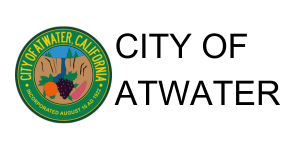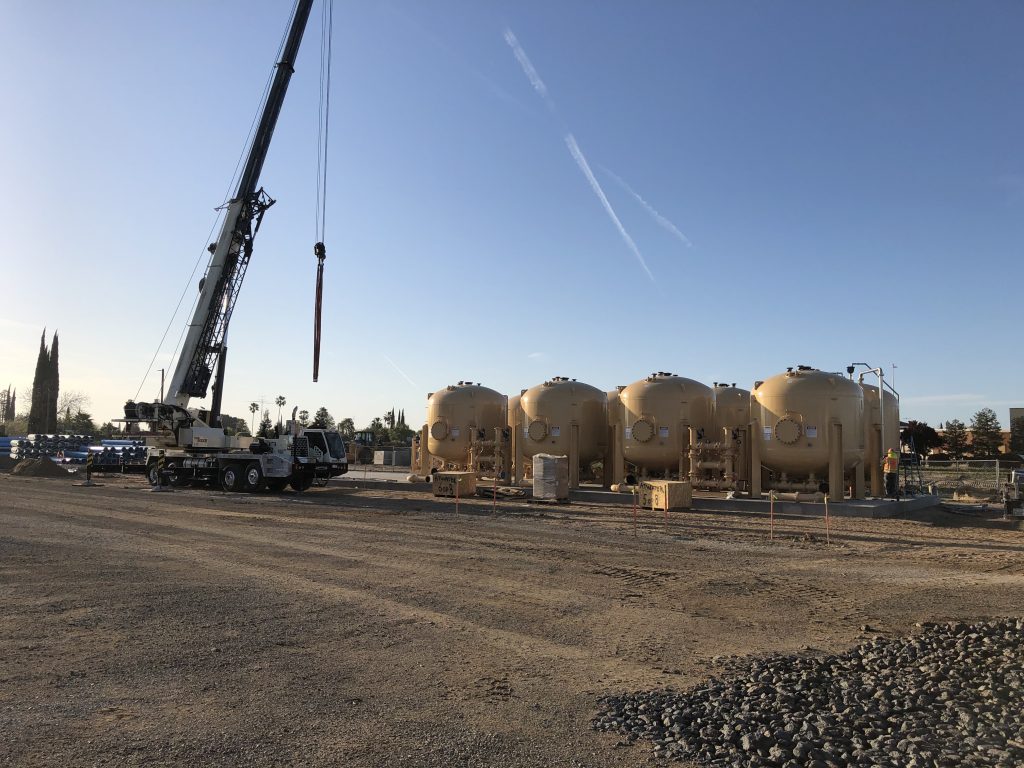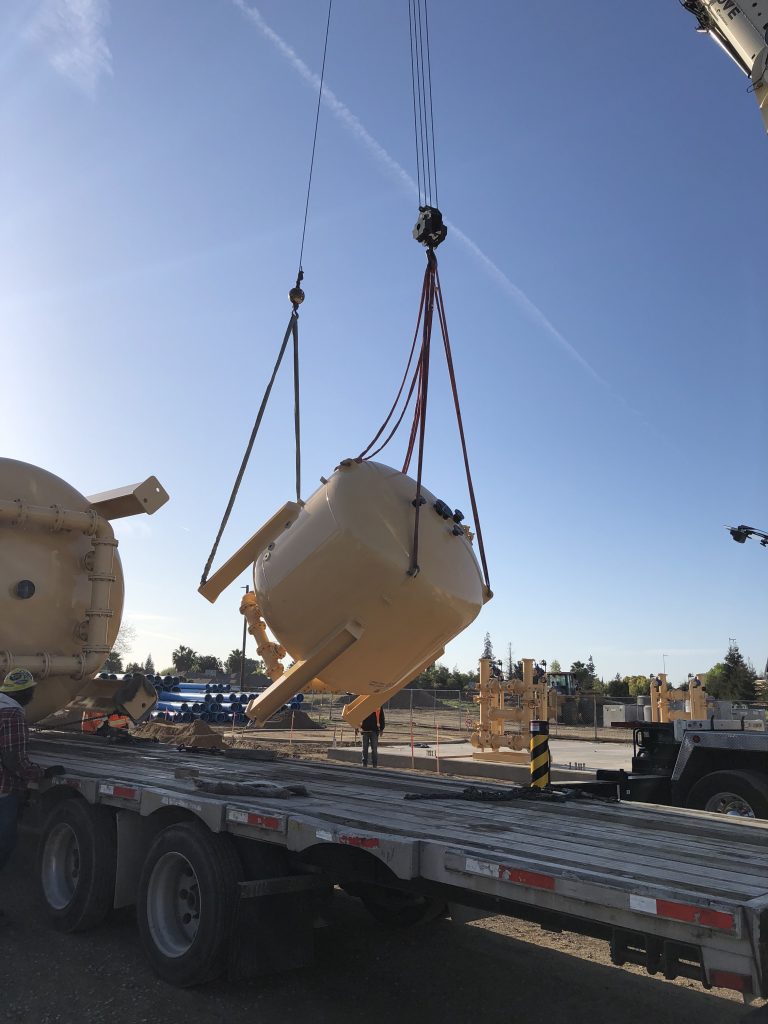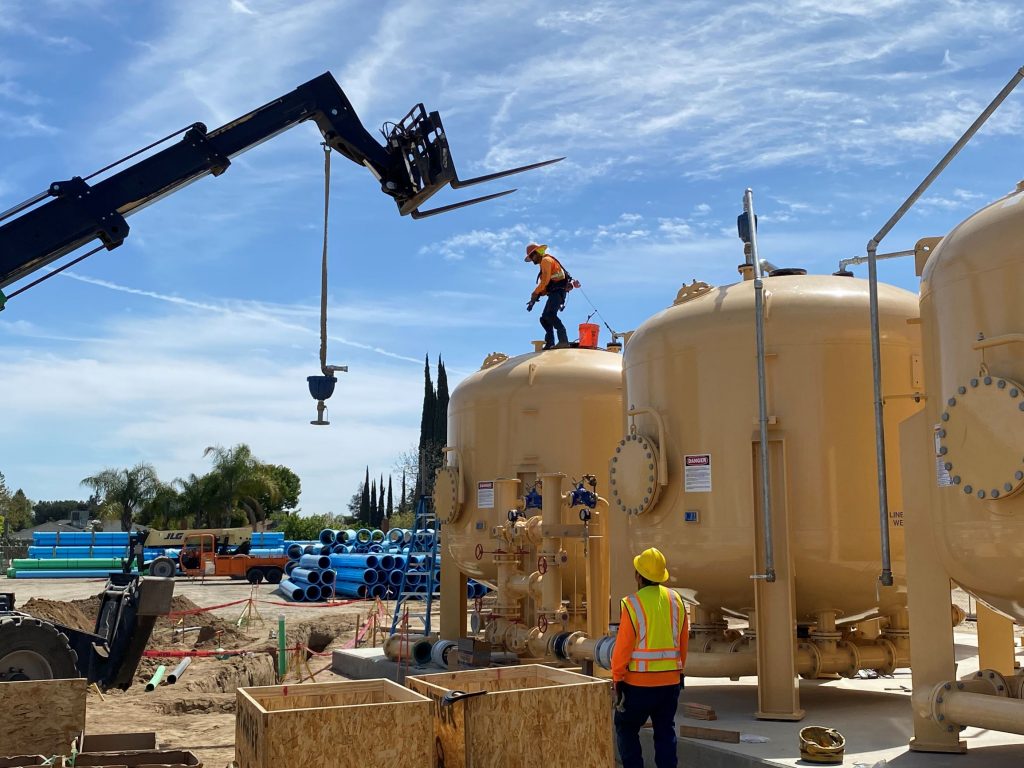TCP Facilities Map
tcp-facilities-mapThe 1,2,3-TCP Project is underway and has made great progress. New treatment vessels have arrived and are being installed at the Central Plant (wells 13, 14, and 17). Well sites 15 and 16 have foundations poured and additional prep work is taking place. Water lines are being installed off of Fruitland Ave, and from Well 17 to Fruitland Ave. We expect new systems to be brought online beginning in June.
Locations of current road construction are shown below. Click on a site on the map for more information about current status and progress photos.
Use the above tabs for additional information and photos for the specific sites.
“Central Plant” consists of Wells 13, 14, and 17 as indicated on the map above.
Latest News:
- Installation of process equipment and piping is complete.
- Coating of the masonry wall is complete.
- Off-site permanent asphalt restoration along north Fruitland Ave and Bellevue/Winton is complete (roadway in front of site remains incomplete).
- Site hardscape installation is nearly complete.
- Initial testing complete with start-up and commissioning mid-October.
Latest News:
- Two new GAC vessels and one piping manifold have been received. Above-grade piping installation is underway.
- Carbon has been removed from the four GAC vessels at the existing treatment site.
- Off-site permanent asphalt restoration is complete.
- Chemical enclosure structure construction is underway.
- Underground electrical nearly complete.
- Initial testing scheduled in late-October, with start-up and commissioning in early-November.
- Demolition and grading of former treatment site is complete.
TCP Remediation Frequently Asked Questions
Q: What is 1,2,3-TCP or TCP?
A: 1,2,3-Trichloropropane (TCP) is a man-made chemical that was for many years contained in pesticide fumigants called nematicides, which farmers applied to soils to kill nematodes, a kind of tiny worm. TCP can pose a risk to public health and can contaminate drinking water.
Q: Why is TCP a concern for Atwater?
A: The City’s drinking water is pumped from the ground. Nematicides marketed by Shell and Dow were used in the Valley for decades, including agricultural lands around Atwater, which led to groundwater contamination. TCP degrades very slowly, if at all, in groundwater and small quantities can contaminate large volumes of water. Most of the City’s wells are pumping groundwater contaminated with TCP.
Q: What does the project do?
A: The 1,2,3-TCP Remediation Project will construct new groundwater treatment systems to remove TCP from the City’s drinking water to below the Maximum Contaminant Level (MCL) of 5 parts per trillion (ppt) (0.000005 mg/l), an amount mandated by the State.
Q: Where is the money coming from to pay for the project?
A: A Merced County Superior Court jury awarded the City of Atwater $63 million dollars in its lawsuit against Shell Oil Company, Dow, and others, for not disclosing that their nematicides contained TCP. The City Council passed a resolution that the proceeds from this lawsuit can only be used to construct and operate the treatment systems to remove TCP from Atwater’s drinking water.
Q: How does the proposed treatment system remove TCP from drinking water?
A: The treatment systems will use granular activated carbon (GAC), which has been identified as the Best Available Technology (BAT) to adsorb TCP as pumped well water flows through it.The treated water is piped into the City’s water mains.
Q: What happens to the TCP after treatment?
A: The TCP adheres to the surface of the granular activated carbon. When the carbon is at the end of its effective life for adsorbing any more TCP, then a vendor will replace it with new carbon and will properly dispose of or regenerate the old carbon in accordance with federal and state laws.
Q: How long will the project take to complete?
A: The target date for completion is April 30, 2021, in accordance with Compliance Order No. 03-11-18R-014, received from the State Water Resources Control Board. Currently, there is a long wait to receive some parts of the treatment systems, so a portion of the project could continue into summer of 2021.
Q: What type of plant will be placed in this residential area?
a. A treatment site, consisting of low profile granular activated carbon (GAC) vessels & backwash tank.
Q: What chemicals will be used at this site?
a. Chlorine/chlorination may be used at some treatment sites for disinfection of the GAC effluent. Chlorination for purposes of disinfection is a well-established technology, a reliable and effective method against a wide range of pathogenic organisms. For additional information on chlorine as a disinfectant check out this fact sheet from the EPA https://www3.epa.gov/pesticides/chem_search/reg_actions/reregistration/fs_PC-020501_1-Feb-99.pdf. Also, California Title 22 Code of Regulations, Chapter 3, Article 10, Section 60353; https://www.waterboards.ca.gov/drinking_water/certlic/drinkingwater/documents/lawbook/RWregulations_20181001.pdf
Q: If chemicals will be used, what about exposure to houses about the area. This property is surrounded on two sides by houses with children.
a. Without chemicals, this project will deliver a heathier water supply to your family. Utilizing GAC adsorption, considered the Best Available Technology (BAT), the purpose and outcome of this project is to remove 1,2,3-TCP levels below the Maximum Contaminant Level (MCL) and provide cleaner, safer, drinking water to the community.
Q: What kind of tanks will be used? How large are they? Will they protrude over the enclosure and be an eye sore to the residents who live in the neighborhood?
a. Please see attached Aesthetics diagram examples. All treatment sites will be designed to minimize visual impacts to our residential community. Tanks will be a maximum of 15 feet tall, treatment sites will be designed and constructed in such a way, as to minimize their height above the surrounding infrastructure. All sites will include masonry walls, wrought-iron-style fencing, as well as, natural vegetative landscaping.
Q: What kind of fencing will be used? Is there going to be a chain link fence with barb wire on top? This is found at other city sites around town.
a. Security will include masonry walls and wrought-iron-style fencing. There are no plans to use chain link fencing or barbed wire.
Q: If this is a filtration system and water will be pumped in and pumped out, how much noise will these pumps make? Will all the neighbors hear pumps running 24 hours a day?
a. No, you and your neighbors will not hear noise nuisances 24 hours per day. The treatment site will contain vessels and tanks, designed to treat and hold water only. Ongoing operation of the site will produce ambient noise at minimal levels during maintenance processes. Additionally, Chapter 8.44 – Noise Control of the Atwater Municipal Code specifically regulates noise levels of construction sites, activities, and equipment within the City of Atwater.
Q: How close to our homes will the equipment be placed?
a. The treatment site on E. Manzanita Drive will be located on the NW portion of the open lot adjacent to your property. Its dimensions are approximately 80’ feet Wide by 180’ feet Long. Inside the 14,400 square foot area will include an approximately 10-foot setback from the existing brick wall structure, from the northern property line boundary, and adjacent residential fencing.
Q: I share over 150 feet of fence line with this property. Who is going to reach out to me and talk to me about the fenceline?
a. As part of the environmental analysis, Initial Study, and CEQA review process, mailers were sent out to all affected residents and agencies within a 200-foot radius of potential treatment and well sites. The treatment site proposed for E. Manzanita Drive will be more than 135 feet from your property line.
Q: Has anyone on the city council considered if this will impact the residents property values?
a. This is a state mandated requirement and will bring the community’s water supply into compliance with SWRCB Compliance Order No. 03-11-18R-014. This will only further positively benefit the area and its value. Property values are considered based on various factors such as: historic sale prices of the area, size, appeal, age, and condition of the home(s). Because this project is to provide healthier, safer, drinking water supply to the community, it is not anticipated to impact resident property values.
Q: Has an environmental report been done?
a. Yes. An Initial Study and Negative Declaration (IS/ND) in accordance with the California Environmental Quality Act (CEQA) was circulated for public review though the State Clearinghouse. A 30-day review period opened on Thursday, July 30, 2020 and concluded on Friday, August 28, 2020. These documents are available for review on the City of Atwater website, the August 31, 2020 Special Council Meeting agenda packet at: https://www.atwater.org/wp-content/uploads/2020/08/CC-Packet-8-31-20-Special-Mtg.pdf (Pages 61-214). They can also be downloaded from the State Clearinghouse website at: https://ceqanet.opr.ca.gov/2020070536/2.
























